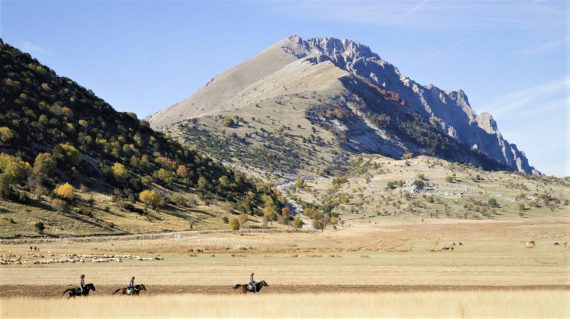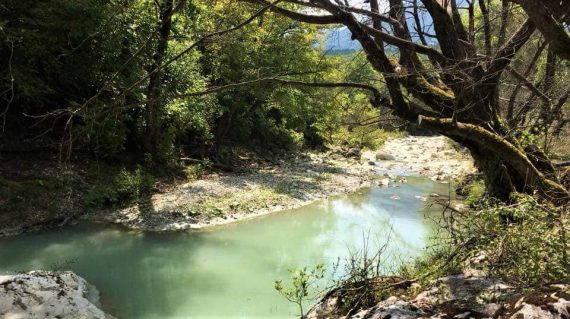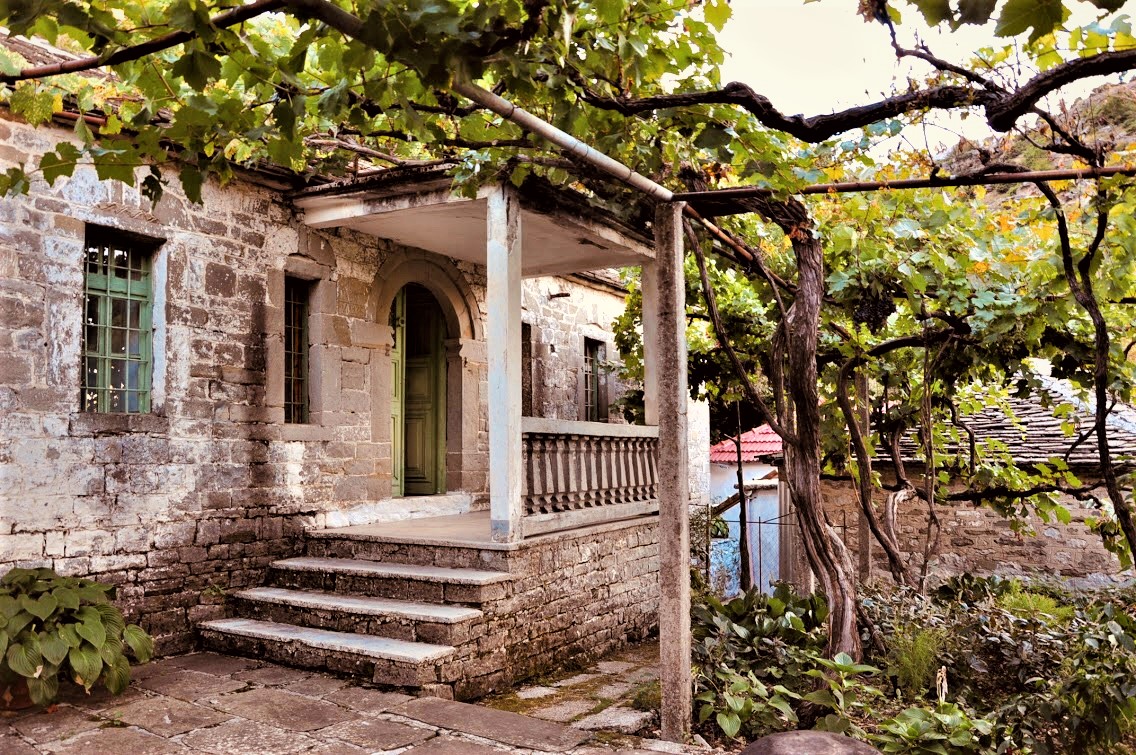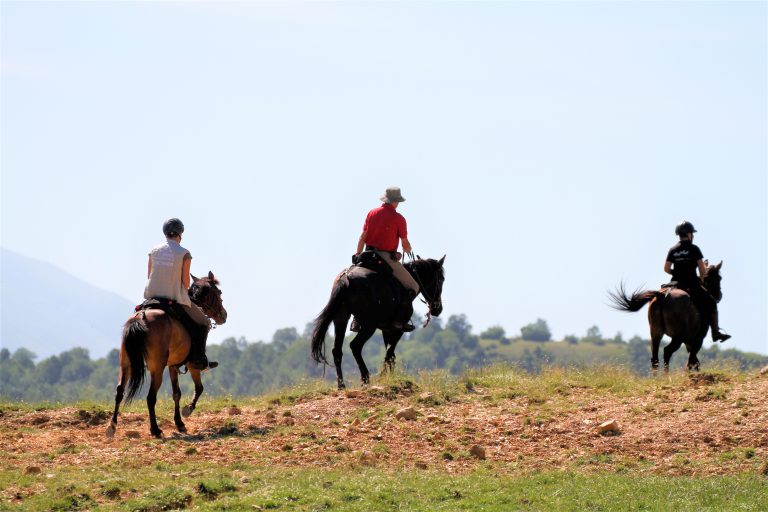
Illyrian Trail
Albania
This trail is a kind of a wayback machine. It runs through ancient Illyrian ruins and medieval villages. We will ride through fairytale-like stone bridges over mountain rivers and visit churches and monasteries built centuries ago, while also encounter traces of Albania’s communist past. We traverse this amazing land on brave, small-framed horses with huge hearts for riding. Welcome to Albania, the land of myths and tales of the past.
-
Days overall8 daysDays in saddle6 days
-
Group size12Available
-
StandardBalkan hospitality (under roofs and in bed linen)Luggageno limit kgFoodlocal cuisine, vegetarian and vegan available
-
Skillswalk, trot, canter, gallop, previous trail riding experience
We ride out to follow in the footsteps of ancient and medieval caravans on a trail that combines beautiful landscapes with Albania’s rich historical and cultural wealth. Along the way we will come across ancient ruins, medieval churches, buildings and remains of the past from various historical periods, as well as traces of a difficult and turbulent modern history. We will meet local residents, stay at their hourse and see the real, everyday life of Albanian families – both those being better-off as well as those living more modestly.
The Albanian team are first and foremost true horse and equestrian enthusiasts. Years ago they took on the challenge of recreating the vanishing breed of the Albanian horse (a mix of tarpan and Arabian horses). The result is a relatively small-framed but energetic, courageous and disciplined trail horse under saddle, perfectly suited for challenging mountainous paths as well as for active, fast riding.
In addition to their love of horses and adventure riding, the team is also passionate about the history and extraordinary heritage of their region. They are eager to share their knowledge of history, both ancient and contemporary, show local customs and tell interesting stories about Albania both past and present.
The trail itself requires solid horse riding skills and good physical condition, previous trail riding experience is definitely a good thing to have. The group will canter in every suitable spot, rain or shine, sharp turns and small jumps also happen while cantering. We recommend riding in helmets.
Rider weight limit for this trail is set to 90 kg / 200 lbs.
- Accomodation in a hotel in Gjirokastra and at local hosts’ houses during the trail ride
- All meals (starting with a dinner on arrival day to breakfast on departure day)
- Local, English-speaking guides for the entire trek
- A horse with full tack and equipment
- Tourist insurance covering high-risk sports
- Flight tickets to and from Tirana / Flight tickets to and from Korfu and ferry to Saranda
- Transfer to and from Tirana (around 90 euro) or Saranda (around 50 euro)
- Entry tickets to Antigonea and donations in churches along the way (around 15 euro in change)
- Optional: single room supplement (30 euro per night, where available, paid on the spot)
- Minor expenses (souvenirs, additional snacks, admission tickets in free time, etc.)
- Optional: tips for guides
- Day 1 Gjirokastër
- Day 2 The Tree Of Life
- Day 3 Caravan path
- Day 4 Treasures of Southern Albania
- Day 5 Time travel
- Day 6 Following in the footsteps of Justinian and Theodora
- Day 7 Last canters
- Day 8 Farewell to Albania



Riders spend the first and the last night at a hotel in Gjirokastra. On the horse trail we stay with local families, at their homes. The standard differs, but we always have a roof over our heads, beds with linen to sleep in and local dishes to enjoy. Rooms are shared, single rooms are available on the first and last night (30 Euro per night). We taste local food and accompany local Albanians in their everyday, routine tasks.
The traditional Albanian quisine is based on different meat and various, delicious types of cheese. Ecological fruits and vegetables, honey, jams, eggs, bread, desserts and sweets will be served, too. We will drink local water, herbs brews, and – of course – local wine and raki.
Equipment
You will ride in good quality English-type trail saddles. Bridles are of regular construction, we use bits. The equipment in general is what most riders are used to.
Every horse is equipped with small saddlebags for water and takeway food (sometimes we eat in the wild, sometimes are hosted for lunch). Additional straps (for attaching a raincoat) might come in handy.
Please note: we recommend using a helmet while riding.
What you should take with you
The tour in Albania is quite comfortable – as for a trail ride. A car transports all our belongings between particular spots. Every night the group is hosted at houses, no need for sleeping bags and mats. During the day you will need only the basic personal belonging (documents, mobiles,), everything else will be waiting at the destination point in the evening.
- passport
- some cash, Euro is common in Albania
- electronics – mobile, camera
- flashlight, headlamps are handy
- a canteen or other water containers (it might be an empty plastic bottle)
- sunscreen
- swimsuit
- head cover (against heat and Sun)
- riding clothes (breeches, gloves, helmet, etc.,)
- trekking shoes/boots
- lightweight raincoat
- flip-flops
| Date | Trip Status | Price | Spots | |
|---|---|---|---|---|
28 February 2026 - 7 March 2026
|
Available, English-speaking guide/pilot |
1430 € |
12 |
|
7 March 2026 - 14 March 2026
|
Available, English-speaking guide/pilot |
1430 € |
12 |
|
14 March 2026 - 21 March 2026
|
Available, English-speaking guide/pilot |
1430 € |
12 |
|
21 March 2026 - 28 March 2026
|
Available, English-speaking guide/pilot |
1430 € |
12 |
|
28 March 2026 - 4 April 2026
|
Available, English-speaking guide/pilot |
1430 € |
12 |
|
4 April 2026 - 11 April 2026
|
Available, English-speaking guide/pilot |
1430 € |
1 |
|
11 April 2026 - 18 April 2026
|
Available, English-speaking guide/pilot |
1430 € |
3 |
|
9 May 2026 - 16 May 2026
|
Full group, English-speaking guide/pilot |
1430 € |
0 |
|
23 May 2026 - 30 May 2026
|
Full group, English-speaking guide/pilot |
1430 € |
0 |
|
6 June 2026 - 13 June 2026
|
Available, English-speaking guide/pilot |
1430 € |
12 |
|
20 June 2026 - 27 June 2026
|
Available, English-speaking guide/pilot |
1430 € |
11 |
|
4 July 2026 - 11 July 2026
|
Available, English-speaking guide/pilot |
1430 € |
12 |
|
8 August 2026 - 15 August 2026
|
Available, English-speaking guide/pilot |
1430 € |
1 |
|
22 August 2026 - 29 August 2026
|
Available, English-speaking guide/pilot |
1430 € |
9 |
|
5 September 2026 - 12 September 2026
|
Available, English-speaking guide/pilot |
1430 € |
9 |
|
19 September 2026 - 26 September 2026
|
Available, English-speaking guide/pilot |
1430 € |
12 |
|
24 October 2026 - 31 October 2026
|
Full group, English-speaking guide/pilot |
1430 € |
0 |
|
31 October 2026 - 7 November 2026
|
Full group, English-speaking guide/pilot |
1430 € |
0 |
|
7 November 2026 - 14 November 2026
|
Available, English-speaking guide/pilot |
1430 € |
5 |
|
14 November 2026 - 21 November 2026
|
Available, English-speaking guide/pilot |
1430 € |
12 |
|
21 November 2026 - 28 November 2026
|
Available, English-speaking guide/pilot |
1430 € |
12 |
|
28 November 2026 - 5 September 2026
|
Available, English-speaking guide/pilot |
1430 € |
12 |























